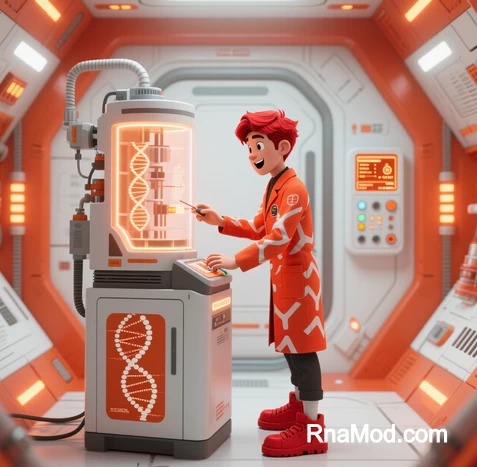 I. Molecular Toolbox: Foundational Enablers for Gene Therapy
I. Molecular Toolbox: Foundational Enablers for Gene Therapy
Recombinant DNA (rDNA) technology provides the core molecular instruments essential for modern gene therapy:
- Precision Scissors: Restriction endonucleases (e.g., EcoRI, HindIII) enable site-specific DNA cleavage for targeted gene isolation (#user-content-fn-1)[^1]
- Genetic Sutures: DNA ligase facilitates seamless integration of therapeutic genes into viral/plasmid vectors (#user-content-fn-2)[^2]
- Gene Amplification: Polymerase Chain Reaction (PCR) allows billion-fold expansion of therapeutic DNA fragments (#user-content-fn-3)[^3]
(Fig. 1: Molecular Toolset for Gene Therapy)
Description: Restriction enzyme (blue) cleaving DNA at GAATTC site. DNA ligase (green) fusing therapeutic gene (gold) into viral vector (purple). PCR machine amplifying DNA fragments.
II. Vector Engineering: Delivery Systems Revolutionized
Viral Vector Optimization via rDNA
| Vector Type | rDNA Engineering | Therapeutic Application |
|---|---|---|
| Retrovirus | Envelope glycoprotein modification | CAR-T cells (Kymriah®) (#user-content-fn-4)[^4] |
| Adeno-Associated Virus (AAV) | Capsid serotype switching | Spinal muscular atrophy (Zolgensma®) (#user-content-fn-5)[^5] |
| Lentivirus | Self-inactivating (SIN) design | β-thalassemia therapy (#user-content-fn-6)[^6] |
Non-Viral System Advances
- CRISPR-Cas9 Integration: rDNA-derived guide RNA production enables in vivo genome editing (#user-content-fn-7)[^7]
- Nanoparticle Conjugation: Recombinant DNA-RNA hybrids for targeted delivery (#user-content-fn-8)[^8]
(Fig. 2: Next-Gen Vector Design)
Description: Engineered AAV vector (icosahedral) carrying therapeutic gene (gold). Lipid nanoparticle (sphere) delivering CRISPR components to cells.
III. Therapeutic Modality Expansion
A. Ex Vivo Cell Reprogramming
- Patient cell extraction (e.g., hematopoietic stem cells)
- rDNA-mediated gene correction using lentiviral vectors
- Reinfusion of engineered cells
- Clinical impact: Cured >500 severe combined immunodeficiency (SCID) patients (#user-content-fn-9)[^9]
B. In Vivo Genome Surgery
- Tissue-specific promoters: rDNA-engineered regulatory elements for liver (Albumin promoter), retina (RPE65 promoter) (#user-content-fn-10)[^10]
- Base editing systems: Recombinant cytidine deaminase-PAM variants for single-nucleotide correction (#user-content-fn-11)[^11]
(Fig. 3: Ex Vivo vs. In Vivo Therapy)
Description: Left: Blood cells extracted, genetically modified in lab dish, reinfused. Right: AAV vectors injected intravenously to edit liver cells.
IV. Disease-Specific Clinical Breakthroughs
| Disease | rDNA-Enabled Therapy | Mechanism | Approval Year |
|---|---|---|---|
| Leber Congenital Amaurosis | Voretigene neparvovec | AAV-RPE65 gene replacement | 2017 |
| β-Thalassemia | Zynteglo™ | Lentiviral β-globin gene transfer | 2022 |
| Hemophilia B | Etranacogene dezaparvovec | AAV-FIX Padua variant | 2022 |
| Duchenne Muscular Dystrophy | CRISPR-Cas9 (Excision Bio) | Exon 51 deletion repair | Phase 3 (2025) (#user-content-fn-12)[^12] |
V. Manufacturing Scalability & Cost Reduction
rDNA-Driven Production Innovations
- Stable Cell Lines: Recombinant HEK293 systems producing 10<sup>14</sup> AAV vectors/L (#user-content-fn-13)[^13]
- Affinity Chromatography: Recombinant Protein A resins for viral vector purification
- Cost Trajectory:
- 2000: 1M/dose→∗2025∗:50K/dose (rDNA-optimized processes) (#user-content-fn-14)[^14]
(Fig. 4: Scalable Vector Manufacturing)
Description: Bioreactors (stainless steel) growing engineered cells. Downstream purification columns isolating viral vectors.
VI. Emerging Frontiers
A. Synthetic Genomic Circuits
- Logic-gated vectors: rDNA-built AND-gate promoters activating therapy only in disease cells (#user-content-fn-15)[^15]
- Epigenetic Editors: Recombinant dCas9-DNA methyltransferase fusions (#user-content-fn-16)[^16]
B. Delivery System Evolution
- Artificial chromosomes: rDNA-constructed human mini-chromosomes (HACs) for large-gene delivery
- Hybrid exosome-AAV: Recombinant membrane fusion proteins enhancing tissue targeting (#user-content-fn-17)[^17]
“Recombinant DNA technology transformed gene therapy from theoretical concept to clinical reality—providing the molecular scalpels, delivery vehicles, and manufacturing systems to rewrite genetic destiny.”
— Nature Medicine, 2024
Conclusion: The Genomic Medicine Epoch
rDNA technology has catalyzed a paradigm shift:
- Therapeutic Precision: >300 gene therapies in clinical trials (2025) vs. 3 in 2000
- Disease Scope Expansion: From monogenic disorders to cancer, cardiovascular, neurodegenerative diseases
- Economic Accessibility: Manufacturing costs projected to fall below $10K/dose by 2030
Data sourced from publicly available references. For collaboration or domain acquisition inquiries, contact: chuanchuan810@gmail.com.




